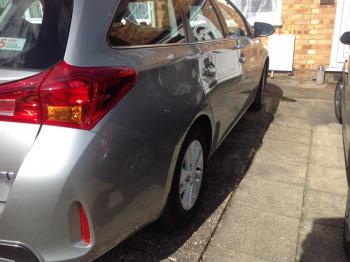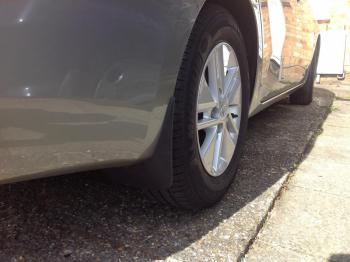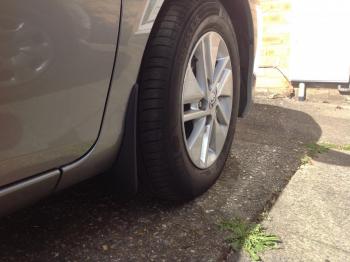Leaderboard
Popular Content
Showing content with the highest reputation on 01/24/2018 in all areas
-
Hi Richard, You've just spent 20 odd thousand pounds on a great car so I can't see why you quibble about £160 to have a decent proper service using the Toyota garage. I would certainly take on board Frosty's comments regarding the warranty. I wouldn't dream of taking my Prius to anywhere other than a Toyota garage for a service. Besides that just remember Toyota agents have the specialised diagnostic equipment needed to maintain the running of their hybrid cars in tip top condition!3 points
-
I owned 1998 1.8 GLS and currently own 2009 1.8 TR Tourer. For 6 months I owned them together so could compare them directly. The lighter Mk1 helps the engine, but most times I find the Valvematic in the Mk3 fine. The Vmatic is more responsive over 2000 rpm, but can be used at lower rpm with no problems. Just be prepared to shift down the gears. On fast roads and motorway the Mk1 is really responsive, because it is in it's peak torque curve, whilst the V Matic can feel lazy. I have to change down to 5th on uphill sections of the A23. Here is the surprising thing, the Mk1 is just as smooth as the Mk3 even though the engine is spinning higher. I have been in every Avensis with a 1.8 engine, and they are all good. The years to avoid unless there is proof that the engine has been replaced, are Mk1 vvti '99-'02 and Mk2 vvti '03-'05 (pre-facelift). If within these years and the engine has been replaced with a later engine or had the official Toyota update (short engine replacement), these cars should be fine too. Slightly even more off subject, the 2 ltr petrol engines were dropped part way through production of both Mk2 and Mk3. Probably to meet emission an fuel consumption targets.2 points
-
Contacted my local toyota dealer to get price for a set of mud flaps on my Auris tourer, was quoted £21.66 inc vat for the flaps which I thought was a good price however they wanted £59.95 to fit. I checked the toyota tech site and it appeared the front flaps directly screwed into holes already there and the back ones needed holes drilled in the rear bumper which I wasn't to keen on doing but figured at the price of the mudflaps I was happy to pay for the whole set and just fit the front ones if need be. Well picked up the flaps today and the instructions don't require any need for drilling the back bumper at all as there are small indentations where the screws need to go and the self taping screw goes through with a little pressure. I am not a big DIY person however the mudflaps were very easy to fit,I had all 4 fitted in less than 20 minutes and to be honest if I now fitted another set I reckon I could do it in 10 mins so for my dealer to be charging £59.95 to fit is criminal. I'm not sure reference the hatchback but would guess fitting is very similar so don't be scared to go for it and fit yourself.1 point
-
See http://blog.toyota.co.uk/toyota-gazoo-racing-2018-yaris-wrc1 point
-
https://newsroom.toyota.co.jp/en/corporate/20623419.html1 point
-
0W-20 and if that isn't available 5W-30 may be used but revert back to 0W-20 when possible. Adhere to the manual. I have entered my reg. into various sites where oil is sold and they have resulted in totally incorrect figures.1 point
-
The 1.8 valvematic petrol engine as fitted to the T27 (2009 on) has plenty power, but needs higher revs to get to it.1 point
-
C0278 = Open or Short Circuit in ABS Solenoid Relay Circuit Trouble Area ABS NO. 2 fuse ABS solenoid relay circuit Brake actuator assembly (ABS solenoid relay) INSPECT ABS NO. 2 FUSE Remove the ABS NO. 2 fuse from the engine room relay block. Measure the resistance according to the value(s) in the table below. Standard resistance Tester Connection Condition Specified Condition ABS NO. 2 (30 A) fuse Always Below 1 Ω No good = replace fuse Good = next step INSPECT SKID CONTROL ECU (+BS TERMINAL) Install the ABS NO. 2 fuse. Disconnect the skid control ECU connector. Measure the voltage according to the value(s) in the table below. Standard voltage Tester Connection Condition Specified Condition A67-3 (+BS) - Body ground Always 11 to 14 V No good = repair/replace harness Ok = next step INSPECT SKID CONTROL ECU (GND TERMINAL) Measure the resistance according to the value(s) in the table below. Standard resistance Tester Connection Condition Specified Condition A67-4 (GND1) - Body ground Always Below 1 Ω A67-1 (GND2) - Body ground Always Below 1 Ω No good = repair/replace harness Ok = Reset DTC DTC other than C0278 occurs = follow new DTC diagnostics if C0278 repeats replace brake actuator assy ( ABS pump ECU is a complete non serviceable unit )1 point
-
1.8 is a cracking motor and in the ones I’ve owned faultless (both post 2006 updates) Sent from my iPad using Tapatalk1 point
-
It would seem to be the case that the sensors are pulsed by the controller every half second or so. As a very rough guide to a proper connection to the bumper sensors, if you put your finger onto the centre portion of each of the sensors you should feel it buzz momentarily every half second(-ish) when it's operating. This is more easily felt with your finger nail. Some years ago I had some aftermarket (Cobra brand, same as the alarm company) sensors mis-triggering intermittantly. I read on a forum that someone with a similar problem had used a very short squirt of WD40, directed in the direction of the circular gap in the sensor head, that had fixed the problem for a while. I was a bit disbelieving, but I tried this, and when the car was sold 2 years later the fault had not reappeared, odd. But the same attempt at a fix made chuff-all difference to a failing OE VW sensor on a different car. On the sensor kits I've fitted, a sticker on the controller warns against disconnecting the sensors with the unit in operation, as it can damage the unit. I don't know if they all can suffer similarly. And In the cheaper kits the instruction warn that if the sensor is too tight in the hole that it can give a false reading, but this seems to settle down over time, so probably not your problem here. Given that all the sensor holes are made with the same drill bit, this advice in the instructions is a bit perverse. On another install I had to mix a Valeo (quite expensive kit) with the controller from an Amazon budget kit. It all worked perfectly. So it would seem there is some (unintentional!) electrical compatibility with certain aftermarket kits. Those two kits had the same connectors/sockets fitted, which made it all easy. HTH1 point
-
hello i have to add something here...since i had same problems i ve spended hours and hours reading posts worlwide... why? we dont want to spend money in the air...ok. toyota mechanics knows for sure how to fix mmt's but they charge from 500 to 2000e. both rg26 and bazhok are rigth 1.gear actuator:if for any reason its been removed or cleaned or u think that its lost its settings just take it out of the gearbox,connect to 12v(car battery) in its motor socket so the rob of the actuator will come out to full lenght.if it pulls in, connect oposite.the acuator has a sensor on top which reads only when the rod is fully out or fully in.<<<ecu and gearbox never reads the lenght of the rod until full length ro sorten,so when ti is in other place gears just stop changing and N flashes>>>. This M A S T be done for sure!!! if u put the actuator again on the gearbox with rob oppend(FULL LENGTH) take care that the gap attached with the "clucht rob" is no bigger than 1mm.toyota says no gap for mmt's but 0.5 to 1.5mm for manuals...isnt the same box?? If other parts are working rigth (clutch,sensors,etc)then ur car will work well. what rg26 has done was right.loosening the 3 bolds, he moved the actuator in a better possition(lucky man).it dosent move clockwise,just left or right by the oval screws.lubed the mechanism is good because it hasnt much grease in it. 2.clutch:if clutch and its plate are worn this is another reason of the problem.1 point










